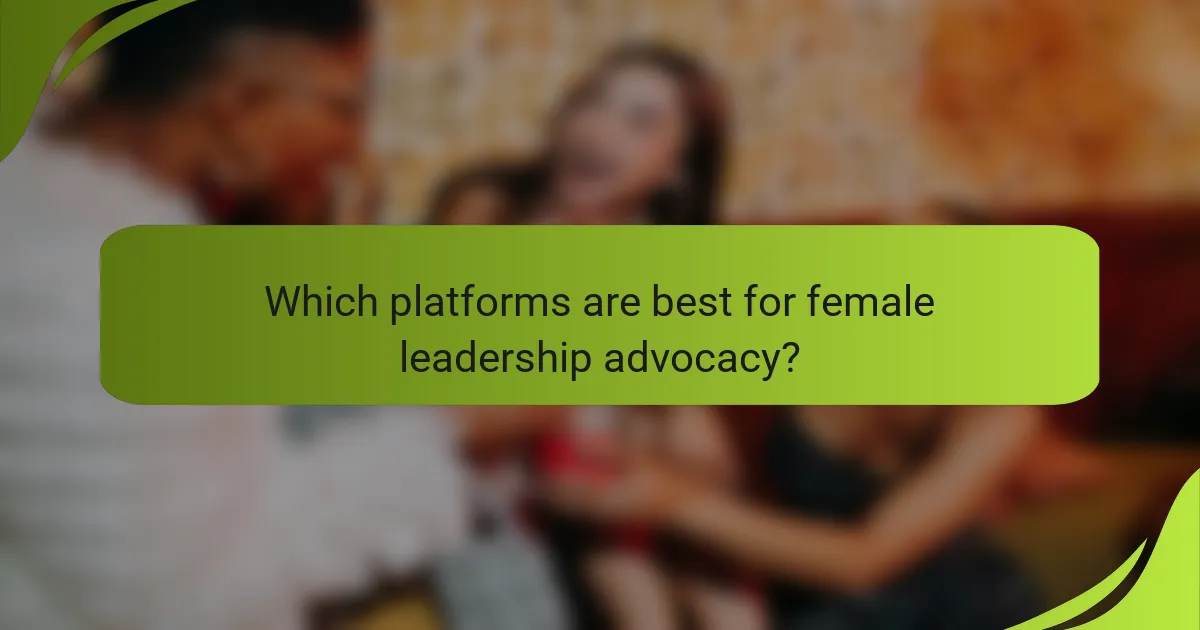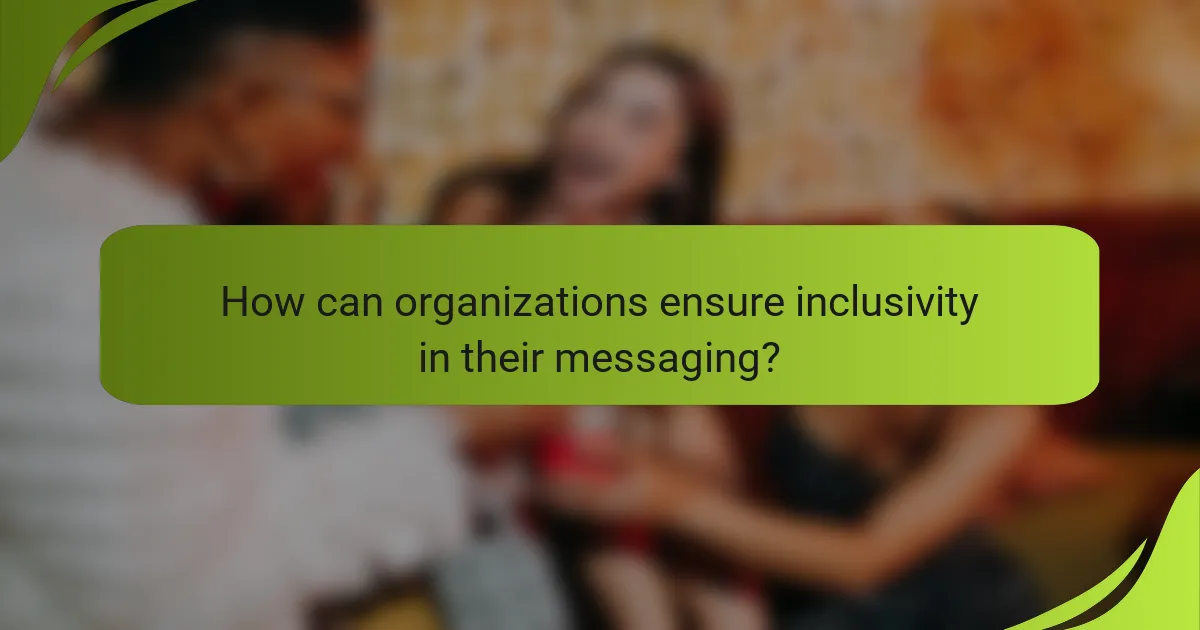In today’s landscape, effective female leadership advocacy campaigns hinge on clear messaging and strategic engagement. By leveraging storytelling, data insights, and diverse voices, these campaigns can create a powerful resonance that drives meaningful change. Crafting compelling messaging that includes a strong value proposition and emotional appeal is essential for mobilizing support and inspiring action.

How can female leadership advocacy campaigns be effectively crafted?
Effective female leadership advocacy campaigns are built on clear messaging, strategic engagement, and community involvement. By focusing on storytelling, data insights, diverse voices, social media, and partnerships, these campaigns can resonate deeply and drive meaningful change.
Utilizing storytelling techniques
Storytelling is a powerful tool in advocacy campaigns, as it humanizes the message and connects emotionally with the audience. Use personal narratives from female leaders to illustrate challenges and successes, making the campaign relatable and inspiring.
Incorporate various formats such as videos, blogs, or podcasts to share these stories widely. Highlighting real-life experiences can motivate others to support female leadership and foster a sense of community around the cause.
Incorporating data-driven insights
Data-driven insights lend credibility to advocacy campaigns by providing evidence of the need for female leadership. Utilize statistics on gender representation, pay gaps, and leadership outcomes to underscore the importance of the issue.
Present this data in visually appealing formats, such as infographics or charts, to enhance understanding and retention. Ensure that the data is sourced from reputable organizations to build trust with your audience.
Engaging diverse voices
Incorporating diverse voices in advocacy campaigns enriches the narrative and broadens the appeal. Include perspectives from women of various backgrounds, industries, and experiences to reflect the multifaceted nature of female leadership.
Engagement can take the form of interviews, guest articles, or panel discussions, ensuring that all voices are heard and valued. This approach not only strengthens the campaign but also fosters inclusivity and solidarity.
Leveraging social media platforms
Social media platforms are essential for amplifying advocacy messages and reaching a wider audience. Use platforms like Twitter, Instagram, and LinkedIn to share content, engage followers, and create discussions around female leadership.
Consider using targeted ads to reach specific demographics or geographic areas, ensuring that the campaign resonates with the intended audience. Regularly update content to keep the conversation alive and encourage ongoing engagement.
Building community partnerships
Forming partnerships with local organizations, businesses, and educational institutions can enhance the impact of advocacy campaigns. Collaborate on events, workshops, or initiatives that promote female leadership and create a supportive network.
These partnerships can provide additional resources, expertise, and visibility, making the campaign more effective. Look for organizations that share similar values and goals to maximize the potential for collaboration and success.

What are the key components of compelling messaging?
Compelling messaging for female leadership advocacy must include a clear value proposition, emotional resonance, and a strong call to action. These components work together to engage the audience and drive them toward supporting female leaders.
Clear value proposition
A clear value proposition articulates the unique benefits of supporting female leadership. It should highlight how diverse leadership contributes to better decision-making and enhanced organizational performance. For example, organizations with women in leadership roles often see improved financial outcomes and innovation.
To craft an effective value proposition, focus on specific advantages such as increased profitability, enhanced team dynamics, or improved company reputation. Use straightforward language that resonates with your target audience, ensuring they understand the tangible benefits of your advocacy.
Emotional resonance
Emotional resonance connects the audience to the message on a personal level. Stories of successful female leaders or testimonials from those impacted by gender diversity can evoke feelings of inspiration and urgency. Highlighting challenges faced by women in leadership can also foster empathy and motivate action.
Consider using visuals, such as powerful images or videos, to enhance emotional appeal. Authenticity is key; ensure that the stories shared reflect real experiences and struggles, making them relatable and impactful.
Call to action
A strong call to action (CTA) prompts the audience to take specific steps in support of female leadership. Whether it’s signing a petition, attending an event, or donating to a related cause, the CTA should be clear and easy to follow. Use action-oriented language that encourages immediate engagement.
To maximize effectiveness, position the CTA prominently within your messaging. Consider using multiple CTAs throughout your campaign to reinforce the message and provide various ways for individuals to get involved. Ensure that each action is straightforward and accessible, catering to different levels of commitment.

Which platforms are best for female leadership advocacy?
Effective platforms for female leadership advocacy include LinkedIn, Instagram, and Facebook, each serving unique purposes in reaching and engaging audiences. Choosing the right platform depends on your campaign goals and target demographics.
LinkedIn for professional networking
LinkedIn is ideal for professional networking and building connections within industries. It allows advocates to share insights, articles, and achievements that highlight female leadership, fostering discussions among professionals.
To maximize impact, regularly post content that resonates with your audience, such as success stories or leadership tips. Engaging with comments and participating in relevant groups can further enhance visibility and connections.
Instagram for visual storytelling
Instagram excels in visual storytelling, making it a powerful tool for showcasing female leaders and their journeys. Use high-quality images, infographics, and videos to convey messages that inspire and motivate others.
Consider using features like Stories and Reels to share behind-the-scenes content or quick tips. Consistent branding and a clear message can help create a recognizable presence that attracts followers interested in female leadership.
Facebook for community engagement
Facebook is effective for building communities around female leadership advocacy. It offers groups and event features that facilitate discussions and networking among like-minded individuals.
Create a dedicated group to foster ongoing conversations and share resources. Regularly post engaging content, such as polls or live Q&A sessions, to encourage participation and strengthen community ties.

What metrics should be used to measure campaign success?
To effectively measure campaign success, it’s essential to focus on key metrics that reflect engagement, conversion, and audience reach. These metrics provide insights into how well the campaign resonates with the target demographic and its overall impact on advocacy for female leadership.
Engagement rates
Engagement rates indicate how actively the audience interacts with campaign content. This can include likes, shares, comments, and other forms of participation across social media platforms or email campaigns. A strong engagement rate typically falls within the range of 1-5% for social media, depending on the platform and audience size.
To enhance engagement, consider using compelling visuals, interactive elements, and clear calls to action. Monitor which types of content generate the most interaction to refine future messaging strategies.
Conversion rates
Conversion rates measure the percentage of audience members who take a desired action, such as signing a petition, donating, or attending an event. A good conversion rate for advocacy campaigns often ranges from 2-10%, depending on the complexity of the action required and the audience’s commitment level.
To improve conversion rates, ensure that the campaign’s messaging is clear and that the call to action is prominent. A/B testing different approaches can help identify the most effective strategies for your audience.
Audience reach
Audience reach refers to the total number of unique individuals who see the campaign content. This metric is crucial for understanding the potential impact of the campaign. Effective campaigns often aim for a reach that exceeds the target audience size by a significant margin, ideally 2-3 times the number of intended recipients.
To expand audience reach, leverage multiple channels such as social media, email newsletters, and partnerships with other organizations. Utilizing targeted advertising can also help to increase visibility among specific demographics interested in female leadership advocacy.

How can organizations ensure inclusivity in their messaging?
Organizations can ensure inclusivity in their messaging by actively engaging diverse voices and perspectives throughout the campaign development process. This involves understanding the unique needs and experiences of different groups to create messages that resonate with a broad audience.
Conducting audience research
Conducting audience research is essential for understanding the demographics, preferences, and values of your target groups. Utilize surveys, focus groups, and interviews to gather insights that reflect the diversity of your audience. Aim to include participants from various backgrounds to ensure a comprehensive view.
Consider segmenting your audience based on factors such as age, ethnicity, and professional background. This segmentation allows for tailored messaging that speaks directly to each group’s interests and concerns, increasing the likelihood of engagement.
Incorporating feedback loops
Incorporating feedback loops is crucial for refining your messaging and ensuring it remains inclusive. Establish channels for ongoing feedback from your audience, such as social media polls or dedicated email addresses for suggestions. This approach helps identify any gaps or biases in your messaging early on.
Regularly review and analyze the feedback received to make necessary adjustments. Implementing changes based on audience input not only enhances the inclusivity of your messaging but also fosters a sense of community and belonging among your audience members.

What are common pitfalls in female leadership advocacy campaigns?
Common pitfalls in female leadership advocacy campaigns include failing to accurately identify and engage the target audience, relying on stereotypes, and not measuring the impact of initiatives. These missteps can undermine the effectiveness of campaigns aimed at promoting female leadership.
Overgeneralizing the audience
Overgeneralizing the audience can lead to ineffective messaging that fails to resonate with specific groups. Campaigns should recognize the diversity within female leadership, including differences in age, race, socioeconomic status, and professional backgrounds.
To avoid this pitfall, conduct thorough audience research to identify the unique needs and motivations of different segments. Tailoring messages to these specific groups can enhance engagement and support for female leadership initiatives.
For example, a campaign targeting young women in tech may focus on mentorship opportunities, while one aimed at women in corporate leadership might emphasize networking and career advancement strategies. Understanding these nuances is crucial for crafting compelling advocacy messages.


